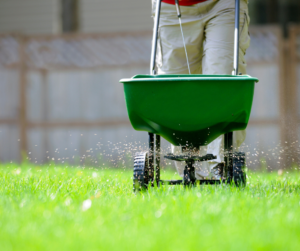 It’s not uncommon to fertilize your lawn in the spring, but don’t be fooled by the milder weather of October. Fall is actually the finest season to fertilize your lawn, much better than spring. With a proper fall fertilizer, grass regains its strength after the summer’s heat and humidity. Fertilizing now also encourages grass to build a robust deep root system, allowing it to withstand the heat better next summer.
It’s not uncommon to fertilize your lawn in the spring, but don’t be fooled by the milder weather of October. Fall is actually the finest season to fertilize your lawn, much better than spring. With a proper fall fertilizer, grass regains its strength after the summer’s heat and humidity. Fertilizing now also encourages grass to build a robust deep root system, allowing it to withstand the heat better next summer.
Where to start.
A soil test is the most accurate approach to discovering which nutrients are deficient in your lawn. Potassium, phosphorus, and nitrogen, as well as the pH of the soil, should all be tested.
Determine whether your lawn is planted with cool-season or warm-season grasses. Cool season grasses, such as ryegrass, fescue, Kentucky bluegrass, and bent grass, benefit from fall fertilizer. Cool season grasses are typically planted in areas that have chilly winters and mild to hot summers.
Selecting a Fertilizer
The three essential components of lawn fertilizer are nitrogen, phosphorous, and potassium. The abbreviation is N-P-K.
Nitrogen strengthens grass and roots. It prevents illness and keeps grass green.
Phosphorus is included in fall fertilizers to promote stronger roots. A phosphorus-rich grass is more resistant to diseases and more tolerant of heat, cold, and drought.
Potassium protects the grass and roots from harsh winter temperatures.
Gypsum could also be present in the fertilizer. It loosens thick clay soils and enhances nutrient uptake. Loose soil facilitates the growth of new spring grass.
The pH of your soil will reveal its chemistry. Apply sulfur if alkalinity has to be lowered. Apply lime if the pH level indicates that acidity needs to be reduced.
A set of three digits on the bag’s label indicate the N-P-K content by weight. A 50-pound package of fertilizer branded 5-10-5, for example, contains 2.5 pounds (5% nitrogen), 5 pounds ( 10% phosphorus), and 2.5 pounds (5% potassium).
Higher numbers imply a higher concentration of nutrients. Because the concentration dictates how much grass area a bag of fertilizer will cover, follow the manufacturer’s application instructions.
Some fertilizers release nutrients quickly, while others release them gradually. Based on your lawn and environment, determine which is ideal for your fall application. Slow-release fertilizers provide more extended, more even fertilizing, whereas fast-release fertilizers supply nutrients to the grass immediately before soil and air temperatures cool.
If your grass receives a lot of shade, it might not need as much fertilizer. Lawns in the shade grow more slowly than lawns in the sun. Check the label for any particular instructions for shaded areas.
Timing
While your grass’s top growth slows or stops entirely in cooler autumn temperatures, the roots are a different story. They typically will continue to grow and thrive.
Three applications of fall fertilizer prepare your yard for winter properly. In early September, begin the initial treatment. The second feeding should be applied in late October, and the third should be applied in December (S-O-D). The N-P-K nutrients support the roots, allowing the grass to remain robust throughout the winter. They also supply reserves for a green and rapid spring growth spurt.
Fertilizer dissolves more easily and quickly in slightly damp soil. If your lawn is really dry, water it thoroughly before fertilizing. Otherwise, the components in the fertilizer will be less effective.
For more information about lawn care and landscaping ideas go to Fallas Landscape.

